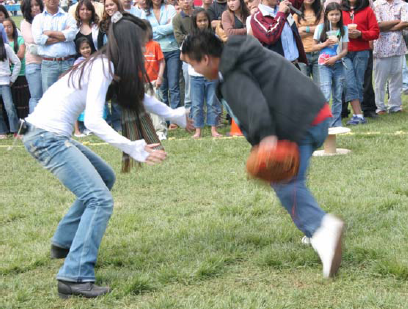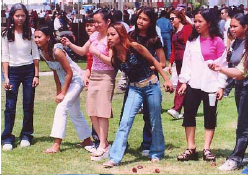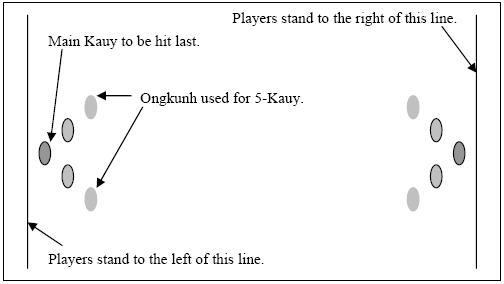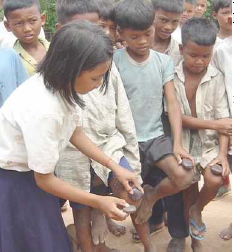
Photograph by Sweet Mango Photography (www.mysweetmango.com)
There are several traditional games played during the Khmer New Year, including Teang Prut, Chaol Chhoung, Bos Ongkunh, Leak Konsaeng, Domderm Sluk Chaue, Sdach Jung, Kuorng/Ktey, Klaeng Jab Kone Mun, and Baykhom. Many of these games are played not just during New Year but at other gatherings as well.
In this section, I will discuss only a few games that I feel are popular during the New Year. These games are: Ongkunh, Chhoung, Teagn Prot, and Domderm Sluk Chaue.

Ongkunh is a type of vine grown in Cambodia (mainly in Stung Treng and Kratie province). It consists of a large stem and contains large and lengthy fruits. [CHH67] Each fruit has several seeds that are circular and flat with 2 to 3 inches in diameter. As the fruit ripens, the seed becomes hard and smooth and turns dark brown. This seed is used for playing the game "Ongkunh". The game is also known as "Boss Ongkunh" meaning to throw the Ongkunh.
There are two styles of the game played-the simple and the extended. The simple style consists of just throwing the Ongkunhs to hit the target Ongkunhs. The extended style adds five more stages in addition to the throwing stage. Both styles end with a penalty called Jours-activity that the winning team members get to perform on the losing team members.

The players are divided into two teams, typically girls versus guys. Each team typically has the same number of people ranging from 2 to 10. There are two boundary lines about 10 to 15 feet apart where each team line up when they are ready to start. Before that, the teams need to decide which team starts to throw first and how many Kauy to play.
There are two types of Kauy-Kauy Boss (កោយបេាះ) and Kauy Dam (កោយដាំ) . Kauy Boss is the Ongkunhs used for throwing and Kauy Dam is the Ongkunhs used as targets. The team can select either 3 or 5 Kauys. If there are less people, three-Kauys are usually selected. Each player of the starting team will be given three or five Ongkunhs according to the number selected.
In addition, each team will take one extra set of Ongkunh for the Kauy Dam. Each team will use this set and will place them on the ground right in the front center of their boundary line in a "V" shape. At each spot that the Ongkunh is to be placed, make a shallow groove on the ground so the Ongkunh can be placed on the ring of the rounded corner. The Ongkunhs will stand up with the flat side facing the other team. See diagram below. For five-Kauys, some people set up in a rectangle shape with the main Kauy in the center.


There are two types of Jours--"By Trorjeak" (បាយត្រជាក់) and "By Kdao" (បាយក្ដៅ) meaning cold rice and hot rice respectively. This should be decided before the game begins. For By Trorjeak, place one Ongkunh on the knee flat on its side and use another Ongkunh to tap on top of the first Ongkunh. This should be a gentle tap. The tap should make a clicking sound.
For By Kdao, it is a harder hit. The winner uses two Ongkunh and holds them in one hand while hitting the knee such that it makes a clicking sound. This can be done by holding the first Ongkunh on the bottom of the palm using the little pinky finger and the ring finger to wrap around the circular edge of the Ongkunh. Then place another Ongkunh vertically so that the round edge almost meets the flat base of the first Ongkunh. Leave the gap from a quarter of an inch to a half of an inch. The second Ongkunh is to be held by the thumb and the index finger. Then hit the knee using the first Ongkunh and within impact the inertia of the second Ongkunh should hit the first Ongkunh and make a clicking sound.
If the clicking sound is not heard, the other person can thump the hitter instead. This repeats until one person is able to make the clicking sound.
This style is more popular since it is simpler to play. To begin, the team that goes first will throw the Kauy Boss to hit the Kauy Dam. The Kauy Dam on the root of the "V" shape is the main Kauy Dam. It can only be hit last after all other Kauy Dams are hit. The throwing team will try to hit as many Ongkunh as they can. A hit occurs when the Kauy Dam falls flat on its side. Sometimes a Kauy Dam is hit but it does not fall thus it does not count as a hit.
As the throwing team begins to throw, one of these three conditions can happen.
This style of play is based on [PHE04A] and has 6 stages. You start with stage one and move on to the next stage in sequential order. Before you move to the next stage you must hit all of the Kauy Dam according to the procedure for each stage. If the throwing team is going to the next stage, all of the Kauy Boss's are returned to the throwing team and all of the Kauy Dams are setup again.
There are three penalty conditions that the throwing team needs to avoid. If any of three conditions occurs or the throwing team runs out of the Ongkunh, the team switches the play and the other team becomes the throwing team. The three conditions for the throwing team to avoid are:
When any of these conditions occur, the Kauy Dams should be left untouched and the throwing team will lose the turn and give all the Kauy Boss to the other team. Each team will continue at the same stage that they were on before the turn was over.
Here are the stages:
The throwing team crouch down and extend one knee forward to use the thigh as a surface to place the Ongkunh. Then use the pointing finger or middle finger to flick the Ongkunh by using the other hand to pivot the flicking finger to aim the Ongkunh at the Kauy Dam. If you hit a Kauy Dam you move on to try to hit another Kauy Dam. The three penalty conditions still apply.
If the Kauy Boss lands near of the Kauy Dam about one finger stretch or less, the thrower asks the other team to choose "Want" or "Gnab" (វ័ន ឬ ងាប់) . If the other team chose "Want", the thrower places his/her thumb on the end of the Kauy Boss and move the pointing finger toward the Kay Dam to flick it and cause the Kauy Dam to fall. If the other team choose "Gnab", the thrower stands next to the Kauy Boss and picks up the Kauy Boss and slam on the Kauy Dam to make it fall. The thrower gets one chance to make the Kauy Dam fall. If the Kauy Dam falls, it is considered a hit.
If the Kauy Boss lands further away, the thrower tries again with another Ongkunh by kneeling down instead and flick the Ongkunh from the thigh. If the Kauy Boss lands close to Kauy Dam about one finger stretch or less follow the above process. In this shot, if the Ongkunh hit the first Kauy Boss, the thrower will have to redo the last two shots using a process called "Kauy Srorleang" (កោយស្រលៀង) (cross-eyed Kauy) and "Kauy Kvak" (កោយខ្វះ) blind Kauy). This process allows the thrower to redo the last two shots by flicking with one eye closed and then follow by the flicking with two eyes closed.
This stage is similar to the See Kole except the player flicks from the ground instead of from the thigh. The penalty rule is also applied the same way as See Kole.
This stage involves rolling the Ongkunh on the ground using the same format as the first stage. There are two methods-Trorkorng Thub (cling and hold), Trorkorng Cha (cling and redo) to be decided before the game begins.
For Trorkorng Thub, the thrower rolls the Ongkunh on the ground toward the target without passing the last Kauy Dam. Then the thrower runs after it and stops the Ongkunh by using the palm to cover the Ongkunh before it stops moving. If the Ongkunh stops before you cover it or you do not cover it completely, this round is over and the team will switch play. If the Ongkunh pass the last Kauy Dam or hit any of the Kkauy Dam, it is considered as a miss. The fallen Kauy Dam will be replaced. If you cover it successfully, you will then flick using your pointing finger or the middle finger from the ground to hit a Kauy Dam.
For Trorkonrg Cha, it does not require to run after and cover it. You will let it stop but it cannot hit the Kauy Dam or pass the last Kauy Dam. If it does, it is considered a missed. Then use the finger to flick from the ground to the Kauy Dam and attempt to hit it.
In this stage you can take one step forward (need to be decided beforehand), then place one Ongkunh on top of the foot. Next, take two steps forward starting with the foot that has the Ongkunh. On the final step, you can swing the foot with the Ongkunh so that the Ongkunh flies off the foot toward the target. The objective is to hit the Kauy Dam.
If the Ongkunh fell off the foot during the first two steps, the player can repeat the procedure, but with a penalty called "Bak Kho Lean Ondat" (បាក់ក លៀនអណ្ដាត) (breaking the neck and sticking out the tongue). The player will redo the shot by looking up to the sky instead of looking at the target and sticking out the tongue. The Kob penalty (when the Kauy Boss hits the Kauy Dam out of its groove and takes its place) is also applied in this stage in addition to the three general penalties.
Vann Pheng suggested that this game probably has hidden meanings relating to agricultural phenomenon. The Kauy Boss possibly represents the rain drop and the Kauy Dam is the plant that grows because of the rain. Ongkunh is also considered a game of the animal and plant's spirits. During the rice growing season, people give offering to the spirits wishing for rain. In the offerings, they include Ongkunh as one of the offerings.
It may be worth mentioning that in Khmer the word "Ongkunh" has a several meanings. Ongkunh is a type of the vine that produces the seed used in the Ongkunh game. It also refers to a knee bone or knee cap. The Ongkunh used in this game is shape like a knee cap and the Jours is to hit the loser's knee cap.
| << Trot | < Table of Content > | Choung ( Leak Konsaeng, Donderm Sluk Chaue, Teagn Prot ) >> |